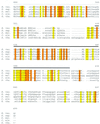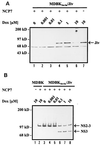A cellular J-domain protein modulates polyprotein processing and cytopathogenicity of a pestivirus
- PMID: 11533209
- PMCID: PMC114514
- DOI: 10.1128/JVI.75.19.9470-9482.2001
A cellular J-domain protein modulates polyprotein processing and cytopathogenicity of a pestivirus
Abstract
Pestiviruses are positive-strand RNA viruses closely related to human hepatitis C virus. Gene expression of these viruses occurs via translation of a polyprotein, which is further processed by cellular and viral proteases. Here we report the formation of a stable complex between an as-yet-undescribed cellular J-domain protein, a member of the DnaJ-chaperone family, and pestiviral nonstructural protein NS2. Accordingly, we termed the cellular protein Jiv, for J-domain protein interacting with viral protein. Jiv has the potential to induce in trans one specific processing step in the viral polyprotein, namely, cleavage of NS2-3. Efficient generation of its cleavage product NS3 has previously been shown to be obligatory for the cytopathogenicity of the pestiviruses. Regulated expression of Jiv in cells infected with noncytopathogenic bovine viral diarrhea virus disclosed a direct correlation between the intracellular level of Jiv, the extent of NS2-3 cleavage, and pestiviral cytopathogenicity.
Figures











Similar articles
-
Persistence of bovine viral diarrhea virus is determined by a cellular cofactor of a viral autoprotease.J Virol. 2005 Aug;79(15):9746-55. doi: 10.1128/JVI.79.15.9746-9755.2005. J Virol. 2005. PMID: 16014936 Free PMC article.
-
DNAJC14-Independent Replication of the Atypical Porcine Pestivirus.J Virol. 2022 Aug 10;96(15):e0198021. doi: 10.1128/jvi.01980-21. Epub 2022 Jul 19. J Virol. 2022. PMID: 35852352 Free PMC article.
-
Cell-derived sequences in the N-terminal region of the polyprotein of a cytopathogenic pestivirus.J Virol. 2003 Oct;77(19):10663-9. doi: 10.1128/jvi.77.19.10663-10669.2003. J Virol. 2003. PMID: 12970452 Free PMC article.
-
Pestiviruses: how to outmaneuver your hosts.Vet Microbiol. 2010 Apr 21;142(1-2):18-25. doi: 10.1016/j.vetmic.2009.09.038. Epub 2009 Sep 30. Vet Microbiol. 2010. PMID: 19846261 Review.
-
The Molecular Biology of Pestiviruses.Adv Virus Res. 2015;93:47-160. doi: 10.1016/bs.aivir.2015.03.002. Epub 2015 Apr 29. Adv Virus Res. 2015. PMID: 26111586 Review.
Cited by
-
Processing of a pestivirus protein by a cellular protease specific for light chain 3 of microtubule-associated proteins.J Virol. 2004 Jun;78(11):5900-12. doi: 10.1128/JVI.78.11.5900-5912.2004. J Virol. 2004. PMID: 15140988 Free PMC article.
-
Essential role of cis-encoded mature NS3 in the genome packaging of classical swine fever virus.J Virol. 2025 Feb 25;99(2):e0120924. doi: 10.1128/jvi.01209-24. Epub 2024 Dec 26. J Virol. 2025. PMID: 39723819 Free PMC article.
-
CRISPR/Cas9-Mediated Knockout of DNAJC14 Verifies This Chaperone as a Pivotal Host Factor for RNA Replication of Pestiviruses.J Virol. 2019 Feb 19;93(5):e01714-18. doi: 10.1128/JVI.01714-18. Print 2019 Mar 1. J Virol. 2019. PMID: 30518653 Free PMC article.
-
Molecular cloning and characterization of a novel human J-domain protein gene (HDJ3) from the fetal brain.J Hum Genet. 2003;48(5):217-221. doi: 10.1007/s10038-003-0012-8. Epub 2003 Apr 25. J Hum Genet. 2003. PMID: 12768437
-
Persistence of bovine viral diarrhea virus is determined by a cellular cofactor of a viral autoprotease.J Virol. 2005 Aug;79(15):9746-55. doi: 10.1128/JVI.79.15.9746-9755.2005. J Virol. 2005. PMID: 16014936 Free PMC article.
References
-
- Collett M S, Larson R, Gold C, Strick D, Anderson D K, Purchio A F. Molecular cloning and nucleotide sequence of the pestivirus bovine viral diarrhea virus. Virology. 1988;165:191–199. - PubMed
-
- Corapi W V, Donis R O, Dubovi E J. Characterization of a panel of monoclonal antibodies and their use in the study of the antigenic diversity of bovine viral diarrhea virus. Am J Vet Res. 1990;51:1388–1394. - PubMed
Publication types
MeSH terms
Substances
LinkOut - more resources
Full Text Sources
Molecular Biology Databases

